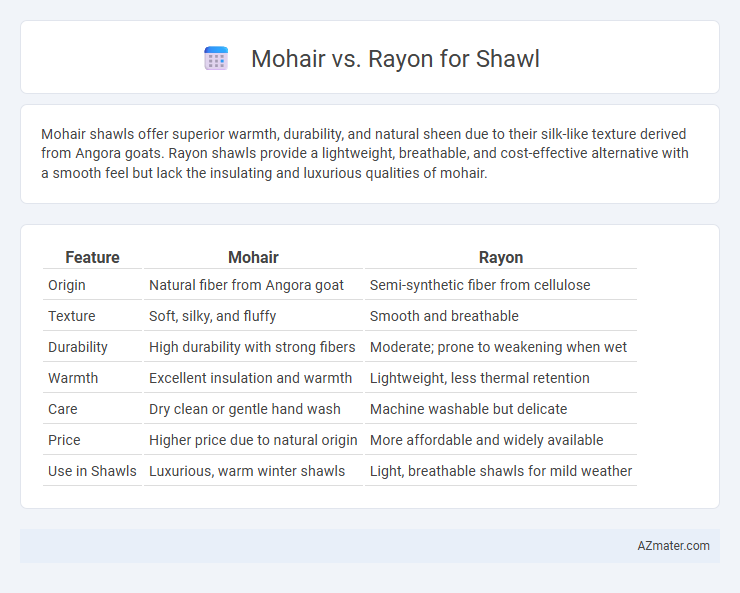Mohair shawls offer superior warmth, durability, and natural sheen due to their silk-like texture derived from Angora goats. Rayon shawls provide a lightweight, breathable, and cost-effective alternative with a smooth feel but lack the insulating and luxurious qualities of mohair.
Table of Comparison
| Feature | Mohair | Rayon |
|---|---|---|
| Origin | Natural fiber from Angora goat | Semi-synthetic fiber from cellulose |
| Texture | Soft, silky, and fluffy | Smooth and breathable |
| Durability | High durability with strong fibers | Moderate; prone to weakening when wet |
| Warmth | Excellent insulation and warmth | Lightweight, less thermal retention |
| Care | Dry clean or gentle hand wash | Machine washable but delicate |
| Price | Higher price due to natural origin | More affordable and widely available |
| Use in Shawls | Luxurious, warm winter shawls | Light, breathable shawls for mild weather |
Introduction to Mohair and Rayon Shawls
Mohair shawls, made from the soft, silky fibers of the Angora goat, offer exceptional warmth, durability, and a luxurious luster that is highly prized in cold-weather accessories. Rayon shawls, crafted from regenerated cellulose fibers, provide a lightweight, breathable alternative with a smooth texture and excellent drape, making them suitable for versatile fashion use. Both materials cater to different needs in shawl design, balancing natural fiber elegance with synthetic adaptability.
Fiber Origins: Mohair vs Rayon
Mohair fiber is sourced from the Angora goat, prized for its natural luster, durability, and insulating properties, making it a premium choice for shawls. Rayon, a semi-synthetic fiber, is derived from regenerated cellulose fibers primarily obtained from wood pulp, offering a smooth, breathable alternative with excellent drape. Comparing fiber origins, mohair's animal-based protein fiber provides warmth and resilience, while rayon's plant-based cellulose origin emphasizes softness and versatility in shawl fabrics.
Texture and Feel Comparison
Mohair offers a luxurious, silky texture with a natural sheen and a soft, lightweight feel that drapes elegantly, making it ideal for high-end shawls. Rayon provides a smooth and cool touch with good drape and breathability, mimicking natural fibers but lacking the unique warmth and resilience of mohair. In terms of feel, mohair is fluffier and warmer, while rayon feels sleek and cooler against the skin.
Warmth and Breathability
Mohair, derived from the Angora goat, offers superior warmth and insulation due to its hollow fiber structure, making it ideal for shawls in colder climates. Rayon, a semi-synthetic fiber made from cellulose, provides excellent breathability but lacks the insulating properties of mohair, resulting in a cooler shawl experience. Shawls made from mohair retain heat effectively while maintaining lightness, whereas rayon shawls excel at moisture absorption and air circulation, enhancing comfort in warmer conditions.
Durability and Longevity
Mohair, derived from the Angora goat, offers exceptional durability and resistance to wear, making it an ideal choice for shawls that endure frequent use and maintain their shape over time. Rayon, a semi-synthetic fiber made from cellulose, tends to have lower durability due to its susceptibility to stretching and weakening when exposed to moisture. Mohair's natural resilience and longevity significantly outperform rayon, ensuring shawls crafted from mohair remain soft and durable through years of wear.
Care and Maintenance Differences
Mohair shawls require gentle hand washing with cool water and mild detergent, avoiding wringing to maintain the fibers' softness and sheen. Rayon shawls need careful laundering as well, but they are more prone to shrinkage and distortion when exposed to heat or agitation, thus often benefiting from dry cleaning. Proper drying methods differ: mohair should be laid flat to dry away from direct sunlight, while rayon shawls also require flat drying but must be shielded from high temperatures to prevent damage.
Color Retention and Dyeing
Mohair fibers exhibit superior color retention due to their smooth, scaly surface, which allows dyes to penetrate deeply and maintain vibrancy over time, making them ideal for shawls requiring long-lasting color. Rayon, a semi-synthetic cellulose fiber, offers excellent dye absorption and a wide range of vibrant colors but tends to fade faster when exposed to light and frequent washing. Shawls made from mohair generally provide more durable and rich coloration compared to rayon, which may require more delicate care to preserve color intensity.
Eco-Friendliness and Sustainability
Mohair, derived from the Angora goat, is a natural fiber celebrated for its biodegradability and renewable sourcing, making it an eco-friendly choice for shawls. Rayon, a semi-synthetic fiber produced from cellulose, often involves chemically intensive processes that raise concerns about environmental impact and resource consumption. When prioritizing sustainability, mohair's minimal ecological footprint and renewable nature typically surpass rayon's comparatively higher environmental costs.
Cost and Accessibility
Mohair shawls tend to be more expensive due to the labor-intensive process of harvesting Mohair fibers from Angora goats and their limited geographic availability, primarily in countries like South Africa and Turkey. Rayon shawls offer a more budget-friendly alternative because they are made from regenerated cellulose fibers, which are mass-produced and widely accessible in many textile manufacturing hubs such as China and India. Accessibility to Mohair is generally restricted by its natural sourcing and seasonal production, whereas Rayon is readily available year-round, making it a cost-effective choice for mass-market shawls.
Best Choice for Shawls: Mohair or Rayon?
Mohair offers exceptional warmth, softness, and natural luster, making it an ideal choice for luxurious and cozy shawls. Rayon, a semi-synthetic fiber, provides breathability and a smooth texture but lacks the insulating properties and durability of mohair. For shawls that prioritize elegance, warmth, and long-lasting quality, mohair stands out as the best choice.

Infographic: Mohair vs Rayon for Shawl
 azmater.com
azmater.com